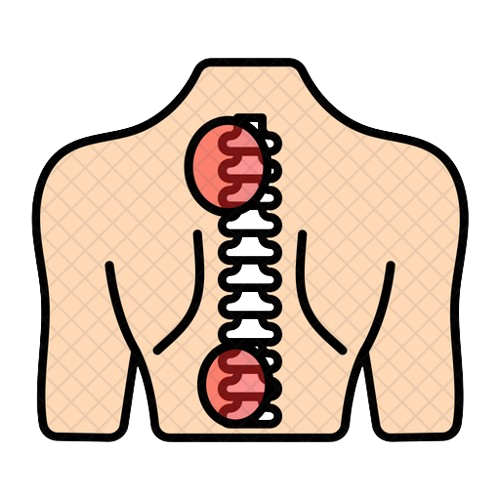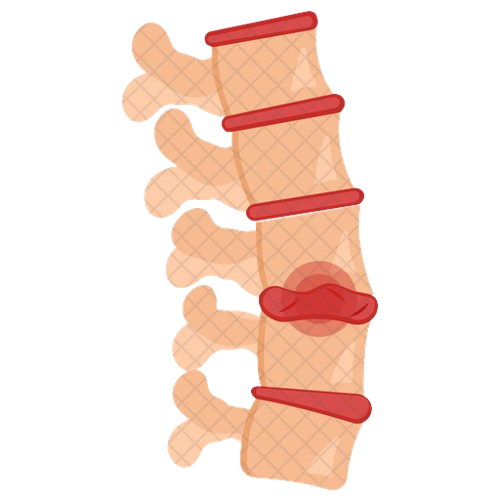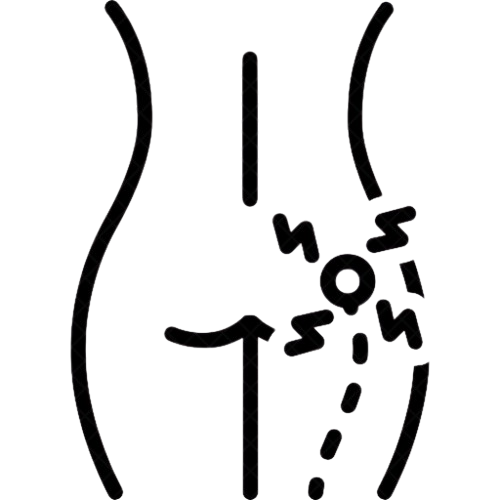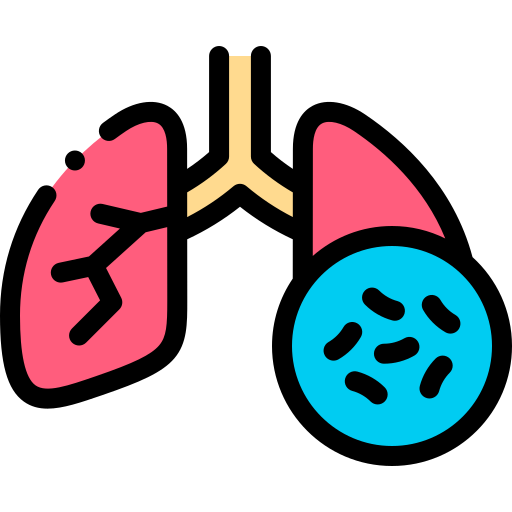Spine TB
- Home >>
- Spine TB
Spine TB
Conditions

Slipped Disc

Degenerative Disk Disease

Sciatica

Slipped Disc
Symptoms of Spinal Tuberculosis
The symptoms of spinal TB can be insidious, starting mild but progressing to severe if untreated. They vary depending on the stage, severity, and location of the infection. Common symptoms include:
- Back Pain: Persistent, deep-seated pain in the spine, often localized but may radiate. It worsens with movement or activity.
- Stiffness and Limited Mobility: Difficulty moving the spine, especially in the morning or after inactivity, due to inflammation and vertebral damage.
- Systemic Symptoms: Low-grade fever, night sweats, fatigue, and general malaise, similar to other TB forms.
- Weight Loss: Unexplained weight loss and loss of appetite as the body fights the infection.
- Neurological Symptoms: Numbness, tingling, or weakness in the limbs due to spinal cord or nerve compression. In severe cases, paralysis (Pott’s paraplegia) may occur.
- Spinal Deformity: Kyphosis (hunchback) or gibbus deformity due to vertebral collapse, especially in advanced cases.
- Localized Tenderness and Muscle Spasms: Painful areas over the spine with involuntary muscle contractions.
- Specific Signs in Advanced Stages: Clumsiness in walking, exaggerated reflexes, or extensor plantar response in cases of neurological involvement.
The lower thoracic (40–50%) and upper lumbar vertebrae (35–45%) are most commonly affected, with cervical spine involvement in about 10% of cases.
Causes of Spinal Tuberculosis
Spinal TB is caused by Mycobacterium tuberculosis, the same bacterium responsible for pulmonary TB. The infection reaches the spine through the following mechanisms:
- Hematogenous Spread: The most common route, where bacteria spread via the bloodstream from a primary TB infection (usually in the lungs) to the vertebrae.
- Direct Extension: Less common, where TB spreads from nearby infected tissues or bones to the spine.
- Contiguous Spread: Infection from adjacent structures, such as soft tissues, can extend to the spine.
- Risk factors include:
- Living in or traveling to TB-endemic areas (e.g., India).
- Immunosuppression (e.g., HIV, diabetes, or malnutrition).
- Close contact with individuals with active TB.
Poor socioeconomic conditions or limited healthcare access.
The bacteria typically infect the vertebral bodies, often starting in the paradiscal region (adjacent to the intervertebral disc), leading to bone destruction, disc involvement, and potential spinal instability.
Diagnosis of Spinal Tuberculosis
Early diagnosis is critical to prevent complications like neurological deficits or deformities. Diagnosis involves a combination of clinical evaluation, imaging, and laboratory tests:
- Clinical Evaluation: A detailed history and physical exam to assess symptoms like back pain, fever, weight loss, or neurological signs (e.g., weakness, numbness). Localized tenderness or deformity may be noted.
- Imaging Studies:
- X-rays: Show vertebral collapse, disc space narrowing, or kyphotic deformity. Early changes may be subtle.
- MRI: The gold standard for detecting spinal TB. It reveals bone destruction, soft tissue abscesses (e.g., paraspinal or epidural abscesses), and spinal cord compression.
- CT Scans: Useful for assessing bony destruction and guiding biopsy.
- Laboratory Tests:
- Complete Blood Count (CBC): May show low hemoglobin and lymphocytosis.
- Erythrocyte Sedimentation Rate (ESR): Elevated in active disease; normalizes during recovery.
- Tuberculin Skin Test (TST) or Interferon-Gamma Release Assays (IGRA): Indicate TB exposure but are not specific for spinal TB.
- Pleural Adenosine Deaminase (ADA): May be used in early diagnosis if pleural involvement is suspected.
- Microbiological Confirmation:
- Biopsy or Aspiration: CT-guided biopsy of the affected vertebra or abscess to confirm Mycobacterium tuberculosis via culture or polymerase chain reaction (PCR).
- Histopathology: Granulomas with caseous necrosis are characteristic of TB.
- Other Tests: Screening for pulmonary TB (chest X-ray, sputum analysis) to identify the primary infection source.
Challenges in diagnosis include atypical presentations and similarity to other conditions (e.g., pyogenic infections, tumors), requiring a high index of suspicion, especially in endemic areas.
Treatment of Spinal Tuberculosis
Treatment of spinal TB involves a combination of medical and, in some cases, surgical interventions. The cornerstone is anti-TB chemotherapy, with surgery reserved for complications. The approach at specialized centers like Sushrut Spine Center, led by experts like Dr. Nevish Patel and Dr. Ankit Khodifad, likely emphasizes multidisciplinary care, though specific details about their protocols are unavailable.
Medical Treatment
- Anti-TB Chemotherapy:
- Standard Regimen: A 6–9-month course of first-line anti-TB drugs, typically:
- Intensive phase (2 months): Isoniazid, Rifampicin, Pyrazinamide, Ethambutol.
- Continuation phase (4–7 months): Isoniazid and Rifampicin
- Extended regimens (12–18 months) may be needed for severe cases or drug resistance.
- Monitoring: Regular follow-up to assess response, manage side effects (e.g., hepatotoxicity), and ensure compliance.
- Adjunctive Therapy: Corticosteroids (e.g., dexamethasone) may be used in cases of neurological involvement to reduce inflammation.
- Standard Regimen: A 6–9-month course of first-line anti-TB drugs, typically:
- Supportive Care: Nutritional support, pain management, and physiotherapy to improve mobility and prevent muscle wasting.
Surgical Treatment
Surgery is indicated for:
Severe neurological deficits (e.g., paraplegia or significant weakness).
- Progressive spinal deformity (e.g., kyphosis >60°).
- Spinal instability due to vertebral destruction.
- Large abscesses or failure of medical therapy.
- Surgical approaches include:
- Debridement: Removal of infected tissue, abscesses, or necrotic bone to reduce bacterial load.
- Bone Grafting: To restore spinal stability and promote fusion. Autografts, allografts, or synthetic materials may be used.
- Internal Fixation: Instrumentation (e.g., rods, screws) to stabilize the spine and correct deformities.
- Approaches:
- Anterior, posterior, or combined surgical approaches depending on the lesion’s location and extent.
- Minimally invasive techniques may be used in select cases to reduce recovery time.
- Post-Surgical Care: Continued anti-TB therapy (12 months or more) and rehabilitation to restore function.
Role of Sushrut Spine Center
While specific information about Sushrut Spine Center’s protocols is not available in the provided sources, it is likely a specialized facility in India offering advanced spine care. Dr. Nevish Patel and Dr. Ankit Khodifad, as spine specialists, would likely provide:
- Expert diagnosis using advanced imaging (MRI, CT) and microbiological testing.
- Comprehensive treatment plans combining anti-TB drugs and surgical expertise for complex cases.
- Multidisciplinary care involving infectious disease specialists, physiotherapists, and rehabilitation experts.
For precise details about their services, contacting Sushrut Spine Center directly or visiting their official website (if available) is recommended.
Best Practices for Spinal TB Management
To ensure the best outcomes:
- Early Diagnosis: Prompt recognition of symptoms and imaging to prevent complications like paralysis or deformity.
- Multidisciplinary Approach: Collaboration between spine surgeons, infectious disease specialists, and radiologists for tailored treatment.
- Adherence to Anti-TB Therapy: Completing the full course of medication to prevent relapse or drug resistance.
- Surgical Expertise: Choosing experienced spine surgeons like those at specialized centers for complex cases requiring debridement or stabilization.
- Rehabilitation: Physiotherapy and nutritional support to restore function and quality of life.
- Follow-Up: Regular monitoring to assess treatment response and detect complications early.
In India, where spinal TB is more prevalent, centers like Sushrut Spine Center likely play a critical role in managing this condition, especially in high-risk populations.
Limitations and Notes
Limited Information on Sushrut Spine Center: The provided sources do not explicitly mention Sushrut Spine Center or Drs. Nevish Patel and Ankit Khodifad in the context of spinal TB treatment. General information about spinal TB is used to address the query, assuming the center offers relevant services.
- Contact for Specifics: For details about the doctors’ expertise, treatment protocols, or success rates at Sushrut Spine Center, direct inquiry with the facility is advised.
- Critical Perspective: While anti-TB therapy is highly effective, challenges like drug resistance, access to care in rural areas, and surgical complications must be considered. Patients should seek centers with proven expertise and advanced facilities.
